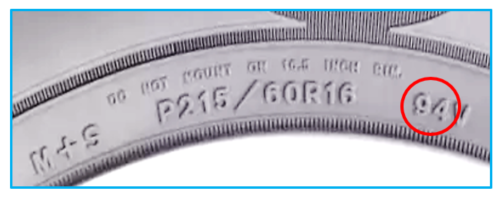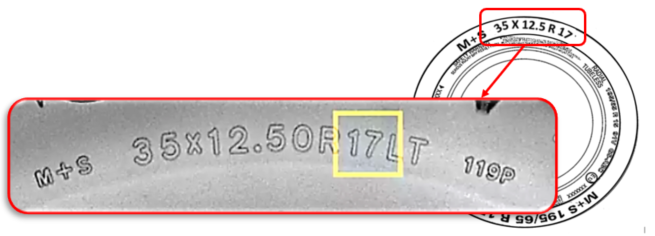Tire Load Capacity
HOW TO DETERMINE TIRE LOAD CAPACITY
The determination of Tire load capacity is based on Ply Rating, Load Index and Load Range.
The amount of air a tire is capable of holding determines the amount of weight the tire can carry. Therefore to achieve a higher tire load capacity, a tire must hold more air. In addition, the tire must be strong enough for it to hold more air volume and pressure.
Consulting the original equipment tires and manufacturers’ suggestion for tire load ratings will ensure the correct tire load capacity.
Tires continue to improve, especially with the use of steel ply materials and radial construction. This makes the Ply Rating Number less effective in determining a tire’s load carrying capacity. Load Index, on the sidewall of a tire, is a newer guide that more accurately provides the tire’s load carrying capacity.
LOAD INDEX
Passenger Car
Tire LOAD INDEX is a number that corresponds to the maximum weight a tire can support with proper inflation. The higher the tire’s load index number, the greater it’s load carrying capacity. So, choosing a tire with a lower load index than the original equipment specifications means that the tire will NOT carry the load capacity of the original.
In this example 94 is the load range. Referencing the Load Range Chart below, the 94 equates to a load carrying capacity of 1,477 lbs.

LOAD INDEX
Light Truck
Light truck tires have two load indexes on the sidewall of the tire, unlike passenger tires, which onlyhave one. This is because you may find light truck tires on vehicles with dual rear wheels.
In this example, the light truck tire has a load index of 117/112. Using the Load Range Chart, the 117/112 load index equates a load capacity for a single tire of 2,833 pounds and a load capacity of 2,469 pounds for two tires.
The reason the capacity for two tires is lower than a single tire is to make sure that the vehicle can continue to carry the load should one tire fail.

TIRE LOAD INDEX CHART
Most passenger car tire load indexes range from 75 to 100, but some are higher. The chart shows how load indexes translate to weight.
| Load Index | Load (lbs) | Load Index | Load (lbs) | Load Index | Load (lbs) | Load Index | Load (lbs) | Load Index | Load (lbs) |
|---|---|---|---|---|---|---|---|---|---|
| 1 | 102 | 31 | 240 | 61 | 567 | 91 | 1356 | 121 | 3197 |
| 2 | 105 | 32 | 247 | 62 | 584 | 92 | 1389 | 122 | 3307 |
| 3 | 107 | 33 | 254 | 63 | 600 | 93 | 1433 | 123 | 3417 |
| 4 | 110 | 34 | 260 | 64 | 617 | 94 | 1477 | 124 | 3527 |
| 5 | 114 | 35 | 267 | 65 | 639 | 95 | 1521 | 125 | 3638 |
| 6 | 117 | 36 | 276 | 66 | 639 | 96 | 1565 | 125 | 3748 |
| 7 | 120 | 37 | 282 | 67 | 677 | 97 | 1609 | 127 | 3858 |
| 8 | 123 | 38 | 291 | 68 | 694 | 98 | 1653 | 128 | 3968 |
| 9 | 128 | 39 | 300 | 69 | 716 | 99 | 1709 | 129 | 4079 |
| 10 | 132 | 40 | 309 | 70 | 739 | 100 | 1764 | 130 | 4189 |
| 11 | 136 | 41 | 320 | 71 | 761 | 101 | 1819 | 131 | 4289 |
| 12 | 139 | 42 | 331 | 72 | 783 | 102 | 1874 | 132 | 4409 |
| 13 | 143 | 43 | 342 | 73 | 805 | 103 | 1929 | 133 | 4541 |
| 14 | 148 | 44 | 353 | 74 | 827 | 104 | 1984 | 134 | 4674 |
| 15 | 152 | 45 | 364 | 75 | 852 | 105 | 2039 | 135 | 4806 |
| 16 | 157 | 46 | 375 | 76 | 882 | 106 | 2094 | 136 | 4938 |
| 17 | 161 | 47 | 386 | 77 | 908 | 107 | 2149 | 137 | 5071 |
| 18 | 165 | 48 | 397 | 78 | 937 | 108 | 2205 | 138 | 5203 |
| 19 | 171 | 49 | 408 | 79 | 963 | 109 | 2271 | 139 | 5357 |
| 20 | 176 | 50 | 419 | 80 | 992 | 110 | 2337 | 140 | 5512 |
| 21 | 182 | 51 | 430 | 81 | 1019 | 111 | 2403 | 141 | 5677 |
| 22 | 187 | 52 | 441 | 82 | 1047 | 112 | 2469 | 142 | 5842 |
| 23 | 193 | 53 | 454 | 83 | 1074 | 113 | 2535 | 143 | 6008 |
| 24 | 198 | 54 | 467 | 84 | 1102 | 114 | 2601 | 144 | 6173 |
| 25 | 204 | 55 | 481 | 85 | 1135 | 115 | 2679 | 145 | 6393 |
| 26 | 209 | 56 | 494 | 86 | 1168 | 116 | 2756 | 146 | 6614 |
| 27 | 215 | 57 | 507 | 87 | 1201 | 117 | 2833 | 147 | 6779 |
| 28 | 220 | 58 | 520 | 88 | 1235 | 118 | 2910 | 148 | 6844 |
| 29 | 227 | 59 | 536 | 89 | 1279 | 119 | 2998 | 149 | 7165 |
| 30 | 234 | 60 | 551 | 90 | 1323 | 120 | 3086 | 150 | 7385 |

As highlighted in the image above, standard tires will indicate the standard tire size. The tire size markings on the sidewall are as follows:
Overall Diameter Height in Inches - 35” in this example
Section Width in Inches - 12.5” or 1250 in this example
Rim Diameter in Inches - 17” in this example
LOAD RANGE/PLY RATING
A letter on the sidewall of a tire represents the load range. This letter provides a comparative value of a tire’s strength, helps gauge how much air a tire can hold and the weight carrying capacity. The higher the Load Range, the more weight carrying capacity of the tire.
Load range comes from an older measurement known as ply ratings. Tires are made up of rubber and cord layers also known as plies. Historically, more plies gave a tire a larger load carrying capacity, so manufacturers would count the tire’s plies and use this number to denote carrying capacity.
However, today’s tire construction uses fewer, stronger plies. Therefore, Load Range basically defines the tire’s toughness and maximum allowable air pressure and not the specific information about its composition. For example, a C Load Range specifies that a tire is equivalent to a 6-ply construction tire. This tire is not actually built of 6 plies, but rather one or two plies of equivalent strength.
Check the tire sidewall to find the letter that indicates the Load Range. Passenger tires do not have markings because they have a standard 4-ply rating. However, you may find Standard Load (SL) or Extra Load (XL or Reinforced). Both these types have a 4-ply rating, but the Extra Load can support additional load at up to 42 PSI, vs. the Standard Load’s 36 PSI.
Ply Rating is on a tire to provide the load carrying capacity at specific tire pressures. Ply Ratings are alphabetic ranging form for A – N with the absence of I and K to prevent confusing with the numeral 1 and a Kilogram (Kilo) respectively.
Refer to charts below for Load Range and Ply Ratings comparison.

Load range chart
Passenger Car
| Load Range | Ply Rating |
|---|---|
| A | 2 |
| B (SL, XL) |
4 |
| C | 6 |
| D | 8 |
| E | 10 |
| F | 12 |
| G | 14 |
| H | 16 |
| J | 18 |
| L | 20 |
| M | 22 |
| N | 24 |
Load range chart
Light truck
| Load Range | Ply Rating | Max. Air Pressure |
|---|---|---|
| B | 4 | 35 PSI |
| C | 6 | 50 PSI |
| D | 8 | 65 PSI |
| E | 10 | 80 PSI |
| F | 12 | 95 PSI |
LT-Metric Tire
(example for illustrative purposes only)